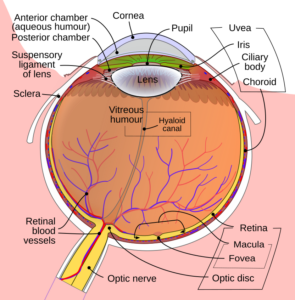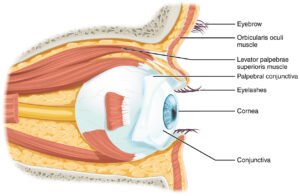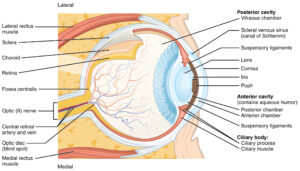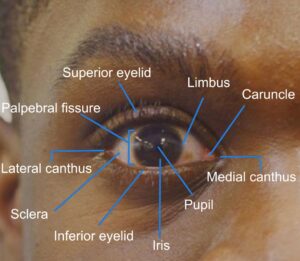Chapter 17 – Ophthalmic System Assessment – The Eyes
Introduction to the Ophthalmic System
The ophthalmic system is important to assess because it is responsible for vision. As a nurse, your assessment of the ophthalmic system provides information about the functioning of this system and potential cues that may require your action.
Ophthalmic System Components
See Figures 1, 2, 3, and 4: Anatomy of the eye for the main components of the ophthalmic system. The main components of the ophthalmic system include:
- Eyelids, eyebrows, and palpebral fissures.
- Pupil, iris, sclera, lens, cornea, conjunctiva, and canthus.
- Lacrimal apparatus.
- Extraocular eye muscles.
- Retina and optic nerve.

Figure 1: Anatomy of the eye.
(By Rhcastilhos. And Jmarchn. – Schematic_diagram_of_the_human_eye_with_English_annotations.svg, Creative Commons Attribution-Share Alike 3.0 Unported license, https://commons.wikimedia.org/w/index.php?curid=1597930).

Figure 2: Anatomy of the eye.
(From: J. Gordon Betts, Kelly A. Young, James A. Wise, Eddie Johnson, Brandon Poe, Dean H. Kruse, Oksana Korol, Jody E. Johnson, Mark Womble, Peter DeSaix, 2022, The Somatic Nervous System. In Anatomy and Physiology 2e. OpenStax. CC BY 4.0 license).

Figure 3: Anatomy of the eye.
(From: J. Gordon Betts, Kelly A. Young, James A. Wise, Eddie Johnson, Brandon Poe, Dean H. Kruse, Oksana Korol, Jody E. Johnson, Mark Womble, Peter DeSaix, 2022, The Somatic Nervous System. In Anatomy and Physiology 2e. OpenStax. CC BY 4.0 license).

Figure 4: Anatomy of the external eye (artist: Tayiba Rahman).
If you want to refresh your knowledge of anatomy and physiology of ophthalmic system, watch this video: Vision: Crash Course Anatomy & Physiology [9:38]
Clinical Tip
The ophthalmic system is closely interconnected with the neurological system, so it is rarely assessed in isolation. Several cranial nerves (CN) innervate the eye and are responsible for visual acuity and eye movement. For example, CN II (optic nerve) allows you to see an object in the distance and see an object off to one side without moving your head or eyes. More to come later in the chapter.

